Correct Answer

verified
Correct Answer
verified
Multiple Choice
Suppose for some firm that average total cost is minimized at Q1 units of output. For a monopolistically competitive firm in long-run equilibrium, Q1
A) is also the level of output at which marginal cost equals average total cost.
B) exceeds the level of output at which there is a point of tangency between the demand curve and the average total cost curve.
C) exceeds the level of output at which marginal revenue equals marginal cost.
D) All of the above are correct.
Correct Answer

verified
Correct Answer
verified
Multiple Choice
Table 16-3
The following table shows the output produced by each of the top eight firms in four industries as well as the total industry output for those industries.  -Refer to Table 16-3. What is the concentration ratio for Industry A?
-Refer to Table 16-3. What is the concentration ratio for Industry A?
A) approximately 52%
B) approximately 58%
C) approximately 66%
D) approximately 72%
Correct Answer

verified
Correct Answer
verified
True/False
A monopolistically competitive firm is a price-taker.
Correct Answer

verified
Correct Answer
verified
Short Answer
Figure 16-13 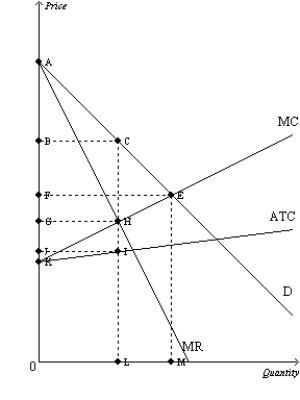 -Refer to Figure 16-13. Use the letters to identify the area of total cost for this firm.
-Refer to Figure 16-13. Use the letters to identify the area of total cost for this firm.
Correct Answer

verified
Correct Answer
verified
True/False
When a firm operates with excess capacity, it must be in a monopolistically competitive market.
Correct Answer

verified
Correct Answer
verified
Multiple Choice
In which of the following market structures can firms earn economic profits in the long run?
A) perfect competition
B) monopolistic competition
C) monopoly
D) Both b and c are correct.
Correct Answer

verified
Correct Answer
verified
Multiple Choice
Table 16-4
This table shows the demand schedule, marginal cost, and average total cost for a monopolistically competitive firm. 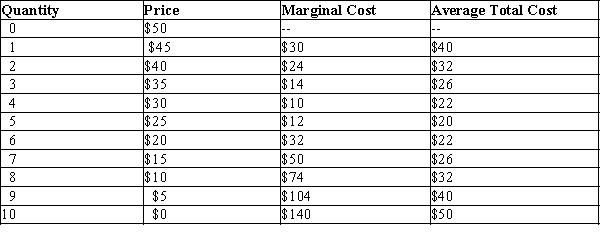 -Refer to Table 16-4. What is this firm's profit-maximizing level of output?
-Refer to Table 16-4. What is this firm's profit-maximizing level of output?
A) 0 units of output
B) 3 units of output
C) 4 units of output
D) 5 units of output
Correct Answer

verified
Correct Answer
verified
Multiple Choice
In the study done by Lee Benham on advertising for eyeglasses,
A) advertising increased the average price.
B) advertising decreased the average price.
C) there was no difference in price, but quality was better in the states that didn't allow advertising.
D) advertising appeared to have no effect whatsoever in the states that permitted advertising.
Correct Answer

verified
Correct Answer
verified
Multiple Choice
Figure 16-9
The figure is drawn for a monopolistically-competitive firm. 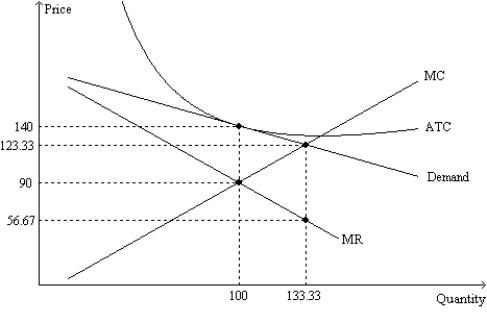 -Refer to Figure 16-9. For this firm, the long-run equilibrium quantity of output is
-Refer to Figure 16-9. For this firm, the long-run equilibrium quantity of output is
A) 100 and the long-run equilibrium price is $90.
B) 100 and the long-run equilibrium price is $140.
C) 133.33 and the long-run equilibrium price is $56.67.
D) 133.33 and the long-run equilibrium price is $123.33.
Correct Answer

verified
Correct Answer
verified
Multiple Choice
Figure 16-2. The figure is drawn for a monopolistically competitive firm.
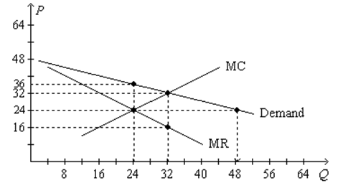 -Refer to Figure 16-2. If the average total cost is $30 at the profit-maximizing quantity, then the firm's maximum profit is
-Refer to Figure 16-2. If the average total cost is $30 at the profit-maximizing quantity, then the firm's maximum profit is
A) $64.
B) $96.
C) $144.
D) $480.
Correct Answer

verified
Correct Answer
verified
Multiple Choice
When a profit-maximizing firm in a monopolistically competitive market charges a price higher than marginal cost,
A) the firm must be earning a positive economic profit.
B) the firm may be incurring economic losses
C) there is a deadweight loss to society, but it is exactly offset by the benefit of excess capacity.
D) new firms will enter the market in the long run.
Correct Answer

verified
Correct Answer
verified
Multiple Choice
Consider a monopolistically competitive firm in a market in long-run equilibrium. This firm is likely earning
A) a positive economic profit since it is charging a price above marginal cost.
B) no economic profit since it is charging a price equal to its marginal cost.
C) a positive economic profit since it is charging a price above its average total cost.
D) no economic profit since it is charging a price equal to it average total cost.
Correct Answer

verified
Correct Answer
verified
Short Answer
Scenario 16-3
Peter operates an ice cream shop in the center of Fairfield. He sells several unusual flavors of organic, homemade ice cream so he has a monopoly over his own ice cream, though he competes with many other firms selling ice cream in Fairfield for the same customers. Peter's demand and cost values for sales per day are given in the table below. (Everyone who purchases Peter's ice cream buys a double scoop cone because it's so delicious.) 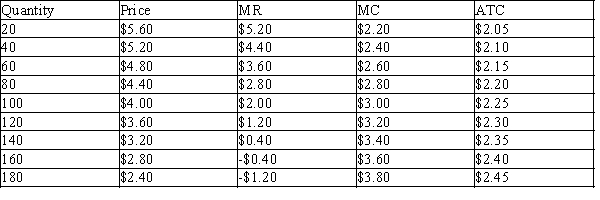 -Refer to Scenario 16-3. How many ice cream cones should Peter sell in one day to maximize his profits?
-Refer to Scenario 16-3. How many ice cream cones should Peter sell in one day to maximize his profits?
Correct Answer

verified
Correct Answer
verified
Multiple Choice
Which of the following statements is correct?
A) Monopolistic competition is similar to monopoly because both market structures are characterized by firms being price makers rather than price takers.
B) Monopolistic competition is similar to perfect competition because both market structures are characterized by differentiated products.
C) Monopolistic competition is similar to oligopoly because both market structures are characterized by strategic interaction between firms in the market.
D) Monopolistic competition is similar to perfect competition because both market structures are characterized by perfectly elastic demand curves for firms.
Correct Answer

verified
Correct Answer
verified
Multiple Choice
In comparison to perfect competition, monopolistic competition is characterized by
A) efficient scale.
B) pricing at marginal cost.
C) excess capacity.
D) All of the above are correct.
Correct Answer

verified
Correct Answer
verified
Multiple Choice
When quality cannot be easily judged in advance, what provides consumers with information about the quality of a product?
A) a brand name
B) a tie-in
C) the quantity available for sale
D) the amount of deadweight loss
Correct Answer

verified
Correct Answer
verified
Multiple Choice
Table 16-1
The following table shows the percentage of output supplied by the top eight firms in four different industries.  -Refer to Table 16-1. What is the concentration ratio in Industry C?
-Refer to Table 16-1. What is the concentration ratio in Industry C?
A) 13%
B) 32%
C) 52%
D) 84%
Correct Answer

verified
Correct Answer
verified
Multiple Choice
A monopolistically competitive firm faces the following demand curve for its product:  The firm has total fixed costs of $120 and a constant marginal cost of $12 per unit. We can conclude that
The firm has total fixed costs of $120 and a constant marginal cost of $12 per unit. We can conclude that
A) firms will exit this market.
B) firms will enter this market.
C) this market is in long-run equilibrium.
D) this firm is operating at its efficient scale.
Correct Answer

verified
Correct Answer
verified
Multiple Choice
A monopolistically competitive market has characteristics that are similar to
A) a monopoly only.
B) a competitive firm only.
C) both a monopoly and a competitive firm.
D) neither a monopoly nor a competitive firm.
Correct Answer

verified
Correct Answer
verified
Showing 201 - 220 of 649
Related Exams